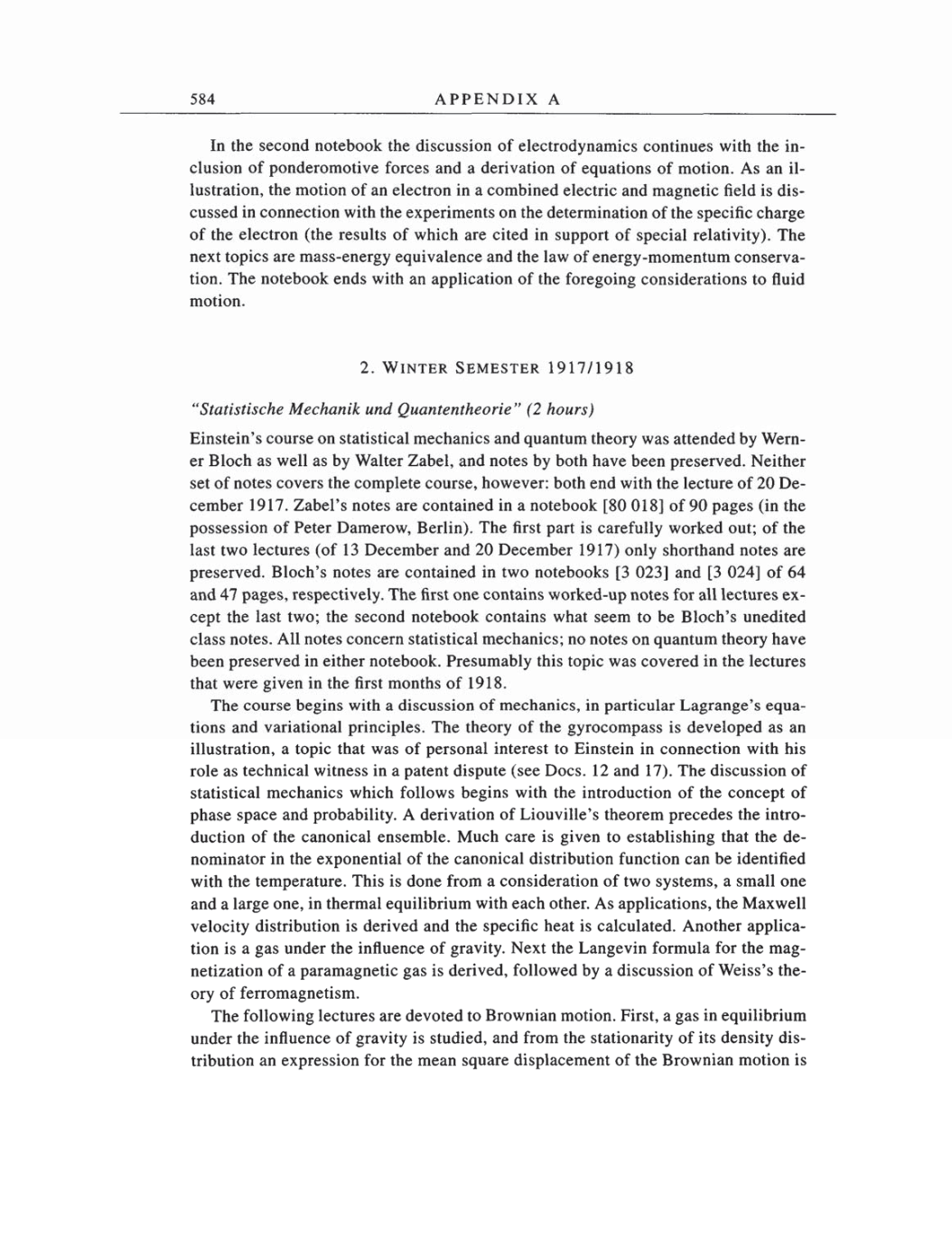584
APPENDIX
A
In the second notebook the discussion of
electrodynamics
continues
with the in-
clusion of
ponderomotive
forces and
a
derivation of
equations
of motion. As
an
il-
lustration,
the motion of
an
electron
in
a
combined electric
and
magnetic
field
is
dis-
cussed
in
connection with the
experiments
on
the
determination of
the specific
charge
of the electron
(the
results of which
are
cited
in
support
of
special relativity).
The
next
topics
are
mass-energy equivalence
and the
law
of
energy-momentum
conserva-
tion. The notebook ends with
an
application
of
the
foregoing
considerations
to
fluid
motion.
2. Winter Semester 1917/1918
“Statistische Mechanik und Quantentheorie"
(2
hours)
Einstein’s
course on
statistical mechanics and
quantum theory
was
attended
by
Wern-
er
Bloch
as
well
as
by
Walter
Zabel,
and
notes
by
both have been
preserved.
Neither
set
of
notes
covers
the
complete course,
however: both end with the lecture of
20
De-
cember
1917.
Zabel’s
notes
are
contained
in
a
notebook
[80
018]
of
90
pages (in
the
possession
of Peter
Damerow,
Berlin).
The first
part
is
carefully
worked
out;
of the
last
two
lectures
(of
13
December and 20 December
1917)
only
shorthand
notes
are
preserved.
Bloch’s
notes
are
contained in
two
notebooks
[3
023]
and
[3
024]
of 64
and
47
pages, respectively.
The first
one
contains
worked-up
notes
for all lectures
ex-
cept
the last
two;
the second notebook contains what
seem
to
be Bloch’s unedited
class
notes.
All
notes
concern
statistical
mechanics;
no
notes
on quantum
theory
have
been
preserved
in
either notebook.
Presumably
this
topic
was
covered in the lectures
that
were
given
in the
first
months of
1918.
The
course
begins
with
a
discussion of
mechanics, in
particular Lagrange’s equa-
tions and variational
principles.
The
theory
of the
gyrocompass
is
developed
as an
illustration,
a
topic
that
was
of
personal
interest
to
Einstein
in
connection with his
role
as
technical witness
in
a
patent
dispute (see
Docs.
12
and
17).
The
discussion of
statistical
mechanics which follows
begins
with the introduction of
the
concept
of
phase
space
and
probability.
A
derivation of Liouville’s theorem
precedes
the intro-
duction of the canonical ensemble. Much
care
is
given
to
establishing
that the de-
nominator in the
exponential
of
the
canonical distribution function
can
be identified
with the
temperature.
This
is
done from
a
consideration of
two
systems,
a
small
one
and
a
large one,
in thermal
equilibrium
with each
other. As
applications,
the Maxwell
velocity
distribution
is
derived and the
specific
heat
is
calculated. Another
applica-
tion is
a
gas
under the influence of
gravity.
Next the
Langevin
formula for the
mag-
netization of
a
paramagnetic gas
is derived,
followed
by a
discussion of
Weiss’s
the-
ory
of
ferromagnetism.
The
following
lectures
are
devoted
to
Brownian motion.
First,
a
gas
in
equilibrium
under
the influence of
gravity
is studied,
and from the
stationarity
of
its
density
dis-
tribution
an
expression
for the
mean
square displacement
of the Brownian motion is
